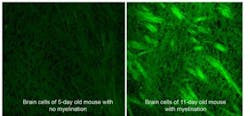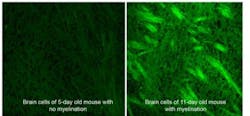Raman imaging can track metabolic changes in living animals
Columbia University (New York, NY) researchers have developed a Raman imaging tool to track changes within individual cells, which combines a chemical tracer with an imaging method called stimulated Raman scattering (SRS). The technique's potential applications include helping surgeons quickly and precisely remove tumors, to helping to detect head injuries and developmental and metabolic disorders.
Related: Vibrational microscopy method generates high-res images of nascent proteins in living cells
"We can use this technology to visualize metabolic activities in a wide range of animals," says Wei Min, a chemistry professor at Columbia University and the study's senior author. "By tracking where and when new proteins, lipids, and DNA molecules are made, we can learn more about how animals develop and age, and what goes wrong in the case of injury and disease."
The breakthrough involves the use of D2O (heavy water) as a chemical tracer. Made by swapping water's hydrogen atoms with their heavier relative, deuterium, heavy water looks and tastes like regular water and in small doses (no more than five tablespoons for humans) is safe to drink. Once metabolized by cells in the body, heavy water is incorporated into newly made proteins, lipids, and DNA, where the deuterium forms chemical bonds with carbon.
As living cells absorb heavy water, deuterium is incorporated into newly made proteins, lipids and DNA. When the researchers aimed the light of a stimulated Raman scattering (SRS) microscope at a single cell, each of the macromolecules above could be identified within. (Image credit: Wei Min lab/Columbia University)
When these carbon-deuterium bonds are hit with light, they vibrate at varying frequencies, the researchers discovered, allowing each macromolecule to be identified as a protein, lipid or DNA. From these frequency signatures, they could track the growth of new proteins, lipids, and DNA in the animal's brain, skin, gut and other organs.
Though heavy water is already used to label proteins and lipids to track metabolic changes, analysis is currently done on a mass spectrometer, on cells extracted from the body. The research team's method, however, now makes it possible to visualize subcellular changes in real time and space. "We get a continuous picture of what's happening inside living animal cells. Previously, we had only a snapshot," says Lingyan Shi, a postdoctoral researcher at Columbia University and the study's co-lead author.
In the study, the researchers diluted regular water with D2O and gave it to roundworms, mice, and zebrafish embryos to drink. Aiming the SRS laser at a variety of tissue, they watched over hours and days as new deuterium-tagged proteins, lipids, and DNA built up.
In one experiment, they watched a bright line emerge around fast-growing brain and colon tumors in the mice. As the cancerous cells divided, more deuterium was incorporated into their newly made proteins and lipids. "This method creates a sharp line between healthy and cancerous tissue, making it much easier to remove the tumor," Shi explains.
Using deuterium-labeled SRS imaging, researchers watched the brain cells of developing mice rapidly put on fat in a process called myelination. The ability to detect normal and abnormal myelination could help in detecting head injuries and monitoring the progression of multiple sclerosis. (Image credit: Min lab/Columbia)
In the roundworm, they watched fat production rise and fall in the worm's reproductive system as it aged. Fat helps the worm's eggs to mature, and once this added fat was no longer useful, fat formation slowed, they found. They also saw clumps of new protein form in the older worm's body, suggesting that deuterium-labeled SRS imaging could be used to track protein deposits, and thus aging-related disease.
In the developing brains of baby mice, they observed the formation of a layer of insulating fat, called the myelin sheath, around each cell. Watching the process in real time suggested to the researchers that deuterium-labeled SRS imaging could be used to tell if a child's brain is developing properly, or if patients suffering from multiple sclerosis, a disease that attacks the brain's myelin and disrupts information flow, might be recovering.
In the sweat gland cells of mice, they watched as new lipids formed in cells at the outer edges of the sweat glands, pushing older cells inward. When those old cells finally reached the center of the glands, they died and were expelled in a process thought to moisturize the skin and hair above.
The technique produces vivid images of metabolic activity in tissues with minimal effort, says Eric Potma, a chemistry professor at University of California at Irvine who was not involved in the study. "As the SRS microscope continues to get smaller, deuterium-labeled SRS imaging may help to catch tumors at much earlier stages."
Full details of the work appear in the journal Nature Communications.


